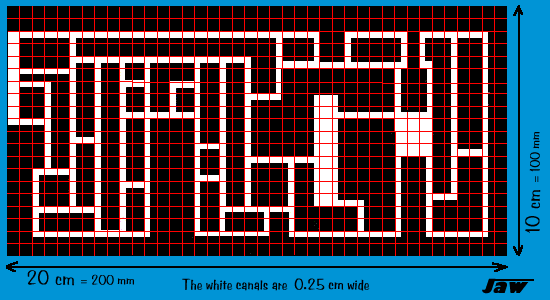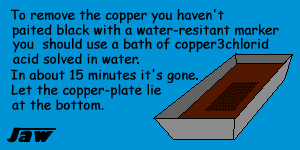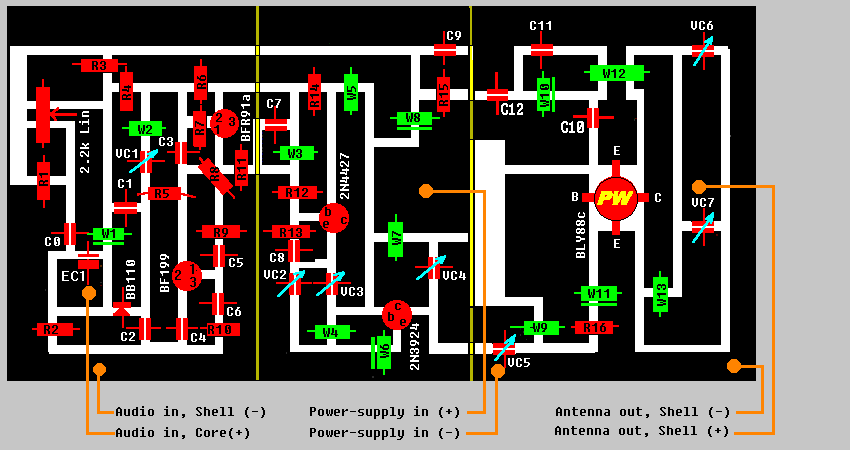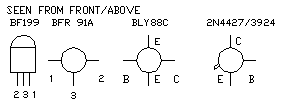| . |
|
15W
Fm-transmitter
It was five years ago when I did an
attempt to build my first fm-transmitter.
It ended in a giant faillure. The only thing it did was interferring
with our tv-set.
Looking back it was due to the lack of information I had. A schematic
was my only help.
Now, five years later, I know a lot more about electro-technics. So I
searched for a schematic
of a stable, tested fm-transmitter with a far reach. I will put all
information you'll
have to know in my page. I made drawings to make things clearer.
As said before: I'm still building it, so I will add information every
time I made progress.
It would be wise for you out there not to start building untill I'm
ready
and have tested it. It has been succesfully built before, but my
succes will give
you a double security. I remind you of the fact that I can also fail.
Intro
Building a good fm-transmitter(88-110Mhz) begins
with getting a good schematic.
You don't have to understand the precise working of the transmitter to
build it.
But some basic information won't harm. A transmitter alone is, as you
probably
know, is not enough to start your radio-station. In the simplest form
you need 4
things. First an input device such as an amplifiler you also use with
your home-stereo.
You can also use a walkman. Details about input-devices in the page:
"Input".
Second you need a regulated power-supply. In this case a 14-18
Volts/2,5-3,5 Ampere.
One of the most influencial things you need is antenna and coax-cable.
More about this
later on. And finally the transmitter itself. You can devide the
transmitter in
two main parts: the oscilator and the amplifiler. The oscilator
converts electric
sound information into electromagnetic waves. The amplifiler gives
these waves
a bigger amplitude.
Building
It's stable and has output of 15-18 watts. This enough to terrorize your wide
surroundings at the fm-band.
The most often used technique to connect the components to each other is
soldering them on a double sided copper-board. Another way is connecting the components floating.
It is cheaper but very tricky. Below you see the copper-board layout(PCB).
I designed it looking closely at the root scheme.

Full size PCB:
PCBGRID.GIF
To get this pattern in copper surface you use a acid bath.
Use a water-resistant permanent marker to paint your own copper-board black in the
pattern the shown above. Color the back side ompletely black. The grid-squares are 0,5*0,5 cm each.
 When the acid has eaten the non-painted copper away you must remove the
When the acid has eaten the non-painted copper away you must remove the
complet thin layer of black paint with sandpaper. Don't remove too much copper with it.
So, now you have the surface to solder the electric components on.
Now a few basic rules for good soldering:
1. Use a special electronics-solderingrod with a slim top.
2. Use soldering-metal with an anti-oxidant-fluid core.
3. Don't heat the components! Heat the connection-point on your PCB.
4. Make sure that the surface is not too smooth.
5. Don't use too much metal.
6. Don't let the soldering metal form a bridge beetween two copper-surfaces.
7. If you're smart you start from the middle of your prepaired board.
In this way you'll have enough space.
Below the schematic. The yellow lines are pieces of copperboard that
devide the transmitter in 3 parts. This is essential. Without them, internal
interferrence will ruin your signal.

This picture is the coldwater-version... For the detailled version:
PCBCOMPLETE.GIF

Components

For readable version:
COMPON.GIF
There are some components that need extra attention. Transistors usually have 3 or 4 different
wires comin' out. If you connect these wires in the wrong way the transmitter won't work.
It may even explode. The picture below shows how to prevent from such an event.

You can find the numbers and letters back in the soldering schematic.
Coils also require extra attention. You can buy the coils trough ferrite in the shop, but
the other ones have to be made yourself. Use 1mm AgCu wire. A coil like 7x/d=10mm/l=15mm,
goes round 7 times, has an diameter of 10 millimeter and is long 15 millimeters.
The best way to make a coil is to bend it around a pencil or other cilindrical shaped object
tight. The diameter of the object is always d-coil minus 1 mm. In this case 9mm.
As I said: bend the wire round (in this case 7times) with the revolves tight together.
To get the desired length stretch the coil when still around the pencil
If you decide to build the transmitter and buy the parts, this list will be handy:
COMPON.DOC
This project is copy - pasted from another
site, but i don't remember it to refer. If you know where the original
site is please e-mail me. I do
it because it is a great project and will be helpfull.
|
|









